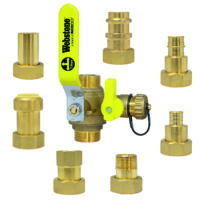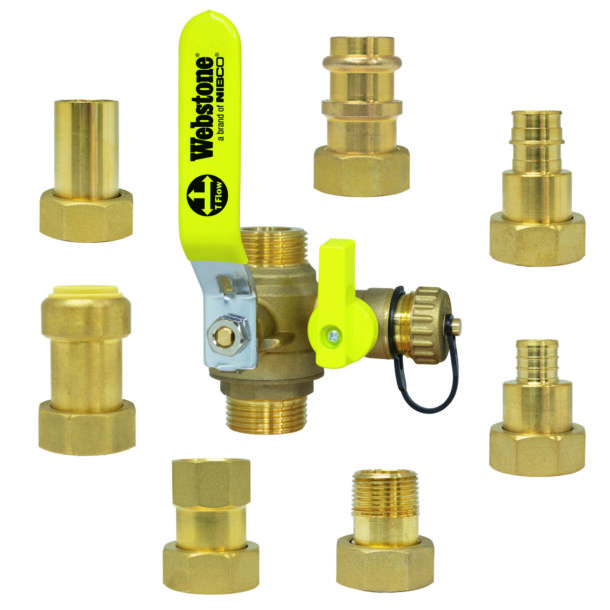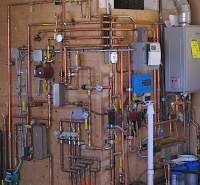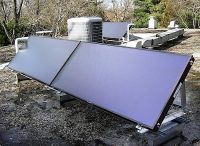Webstone’s new G-Series products enable users the flexibility to create a variety of connection combinations for hydronic, plumbing, hydronic, radiant, solar and geothermal applications. These lead-free, dezincification-resistant brass valves and fittings feature G-threads and G-unions, making it easy to mix and match end connections to create the perfect products for any job. More than 250 Read more
Solar

Webstone’s new G-Series products enable users the flexibility to create a variety of connection combinations for hydronic, plumbing, hydronic, radiant, solar and geothermal applications.
These lead-free, dezincification-resistant brass valves and fittings feature G-threads and G-unions, making it easy to mix and match end connections to create the perfect products for any job. More than 250 different combinations can be created from a single G-Series valve body for a completely custom installation.

End connection fittings are available in FIP, MIP, SWT, Press, Push, F1960 PEX, or F1807 PEX, in piping sizes 1/2″ – 2″. New G-Series products include two ball valves, two Pro-Pal® Ball Drains™, two pressure gauge fittings, an isolation valve, a union fitting, and an end cap. Press transition bodies are also available on select products to save even more time, with quick, clean, and consistent results.
For more information on NIBCO’s Webstone G-Series product line, visit: www.nibco.com/brands/webstone/g-series/.

A leading solar integrator in the San Luis Valley of southern Colorado, Solar Gain Services has been offering solar thermal and photovoltaics to commercial and residential clients since 2007. When co-owner Luke Christy—NABCEP certified as both a solar heating installer and as a PV installation professional—received a call from a homeowner in Sagauche, Colo., to Read more
A leading solar integrator in the San Luis Valley of southern Colorado, Solar Gain Services has been offering solar thermal and photovoltaics to commercial and residential clients since 2007.
When co-owner Luke Christy—NABCEP certified as both a solar heating installer and as a PV installation professional—received a call from a homeowner in Sagauche, Colo., to reduce the overall energy usage footprint as low as reasonably possible, he had the tools and pedigree to meet the energy challenge. The 2,000-sq.-ft. home was built to LEED Gold standards, is heavily insulated, incorporates passive solar features, and has a grid-tied solar electric system to help offset the electrical energy consumption.

The solution, after taking into account available budgets and the highly efficient home, was to install a hybrid combi-system—for domestic hot water (DHW) and radiant floor heat—with a large amount of thermal storage. A copper single pass tube coiled within the tank serves as the primary means of heating DHW. Since the tank is purposely stratified, with the top of the tank always being charged first. “This technique works very well,” says Christy. A setpoint control activates a Caleffi 3-way valve to divert water from the single-pass through the tankless heater when the tank temperature is low.
 Eight installed Viessmann Vitosol 100 solar collectors heat a 700-gallon custom stainless steel tank through a brazed plate heat exchanger, and Christy opted to go without a mod-con boiler for back-up heat to reduce costs. Instead, a gas-fired tankless water heater paired with a plate heat exchanger and some control logic serves as a back-up heat source.
Eight installed Viessmann Vitosol 100 solar collectors heat a 700-gallon custom stainless steel tank through a brazed plate heat exchanger, and Christy opted to go without a mod-con boiler for back-up heat to reduce costs. Instead, a gas-fired tankless water heater paired with a plate heat exchanger and some control logic serves as a back-up heat source.
A Caleffi iSolar BX solar controller charges the storage tank in two vertical stages to ensure that the top of the tank is always as hot as possible, even in winter. This helps preheat DHW through a single-pass copper coil heat exchanger, and in practice the thermal system is able to supply solar heated DHW for most of the year without any assistance from the gas water heater. “A Caleffi BX differential controller was selected because of its ability to charge the tank in upper and lower stages. This is accomplished via a Caleffi 3-way valve that diverts the flow to the tank from the water side of the heat exchanger. This helps the upper stage stay hotter at times of low solar harvest,” says Christy.
The radiant floor distribution system extracts heat from the storage tank until a low temperature setpoint is reached, at which point the gas-fired backup is enabled. “We have used Caleffi products since 2007, when they were introduced to us by Low Energy Systems in Denver. As a system designer I appreciate the extremely high level of quality of the products, as well as the comprehensive range of products available,” says Christy.
 In addition to the solar controller, Christy relied on Caleffi components throughout the install, including four Caleffi thermostatic operator zone valves, an air separator, a backflow preventer and pressure reducing valve, a balancing valve, two thermostatic mixing valves, two 3-way zone valves, flowmeter, eight sweat union connectors—used for making plate heat exchanger connections—and a small automatic air vent. In fact, the radiant loop extracts heat from the storage through a second plate heat exchanger, and delivers it to the radiant slab through an assortment of Caleffi products — a thermostatic mixing valve, a balancing valve, a bypass valve and zone valves.
In addition to the solar controller, Christy relied on Caleffi components throughout the install, including four Caleffi thermostatic operator zone valves, an air separator, a backflow preventer and pressure reducing valve, a balancing valve, two thermostatic mixing valves, two 3-way zone valves, flowmeter, eight sweat union connectors—used for making plate heat exchanger connections—and a small automatic air vent. In fact, the radiant loop extracts heat from the storage through a second plate heat exchanger, and delivers it to the radiant slab through an assortment of Caleffi products — a thermostatic mixing valve, a balancing valve, a bypass valve and zone valves.
Challenges Met
One challenge in particular was the lack of a proper mechanical space for the system piping and components. Once the solar storage tank was in place, Christy realized that the space could be sheathed in plywood and used as a substrate for mounting components. However, we ended up needing all the available area of the tank exterior, which resulted in the system completely covering and wrapping around the tank.
Another challenge was the homeowners desire for solar collectors in a specific place, which was about 150’ away from the mechanical area. This resulted in a very long pipeline to and from the collectors, with potential flow and heat loss issues. These issues were resolved by using oversized and heavily insulated underground piping, as well as a larger collector loop pump.
Customer ‘Pipes’ In
 This system has just gone through its third winter of operation and has been an outstanding success, with a glowing report from the homeowners and zero service calls. The homeowners report that they are comfortable all year round and only refill their 250-gallon propane tank once a year. The single tank supplies all the fuel for the heating and DHW backup, as well as a gas range and a gas fired clothes dryer, so the savings would seem to be significant. On future installations of this kind we will be installing a web-connected energy meter, which will enable us to collect enough system data to translate the daily energy harvest into the corresponding economic benefits.
This system has just gone through its third winter of operation and has been an outstanding success, with a glowing report from the homeowners and zero service calls. The homeowners report that they are comfortable all year round and only refill their 250-gallon propane tank once a year. The single tank supplies all the fuel for the heating and DHW backup, as well as a gas range and a gas fired clothes dryer, so the savings would seem to be significant. On future installations of this kind we will be installing a web-connected energy meter, which will enable us to collect enough system data to translate the daily energy harvest into the corresponding economic benefits.
“The homeowners have had nothing but good things to say about the system. We did not have a single callback on the system until a severe windstorm damaged some collector mounting hardware three years after the system was commissioned. When we checked system operation at that point, everything was still performing properly, with no leaks or control glitches,” says Christy.
Caleffi Excellence
According to Christy, Callefi’s commitment to innovation and constant improvement is extremely important, as is their commitment to education and training. The Coffee with Caleffi webinar series and their Idronics publications are a really valuable resource for the hydronics professional constantly looking to hone his/her skills.

How’s business? Have some electrical experience? Well, it’s a great time to be in solar. Solar is and has been the fastest growing industry in the country, and will continue to be for the foreseeable future. Why you ask? Well, we know that fossil fuels costs are at the lowest they have been for a Read more

How’s business? Have some electrical experience? Well, it’s a great time to be in solar. Solar is and has been the fastest growing industry in the country, and will continue to be for the foreseeable future.

Why you ask? Well, we know that fossil fuels costs are at the lowest they have been for a few years, and will eventually go back up. Solar PV, the price of panels and the balance of the solar system has dropped 60% in the past five years, and continues to go down. Solar is at “grid parity”, which essentially boils down to being cheaper that the cost of the local utility, in 25% of country. And, we know that large, monopoly, investor owned utility companies are not going to start charging us less!? So the common phrase, the answer rises each morning…. The sun!
 So lets take an average solar market like, let’s say Missouri. Not a random pick, but a good example of state with average utility rates. As you can see in this info graphic, solar is creating good paying jobs, and a lot of them! Yes, a naysayer could point out that there is a tax credit involved, but it is really no different than what the massive utilities receive for building power plants and the tax breaks that the big oil companies get every day.
So lets take an average solar market like, let’s say Missouri. Not a random pick, but a good example of state with average utility rates. As you can see in this info graphic, solar is creating good paying jobs, and a lot of them! Yes, a naysayer could point out that there is a tax credit involved, but it is really no different than what the massive utilities receive for building power plants and the tax breaks that the big oil companies get every day.
How do you get into the industry? Well, it starts with some training, check out a places like NABCEP, Midwest Renewable Energy Association, and Solar Energy International or your local tech school. But make sure to do your research. There are a lot of fly by night trainings orgs right now, because of how hot the industry is. I see John and Eric promoting the trades all the time through Mechanical Hub, and while I am one of the go-get-a-liberal-arts-degree-type guys, I absolutely value and promote getting any type of education as long as it is good training.
Shine on! Nick

Located in Bethesda, Md., the Seymour Krieger House is listed on the National Register of Historic Places, and was designed in the 1950s by internationally renowned modernist architect Marcel Breuer. The house currently is owned by an architect, and he wanted to restore the mechanical system while keeping the architectural integrity of the structure intact Read more
Located in Bethesda, Md., the Seymour Krieger House is listed on the National Register of Historic Places, and was designed in the 1950s by internationally renowned modernist architect Marcel Breuer.

A very tight mechanical room displaying a Triangle Tube Prestige boiler, Grundfos ALPHA pump, Caleffi hydro-separator and REHAU radiant tubing and manifold.
The house currently is owned by an architect, and he wanted to restore the mechanical system while keeping the architectural integrity of the structure intact. Originally heated by a radiant floor heating system, the original boiler was still in place and operational, but the wrought iron radiant piping has corroded and was leaking in multiple locations.
“We discussed multiple alternatives,” says Dan Foley, Foley Mechanical, Inc. “But in the end, the owner decided to go back with radiant floor heat.
The bluestone floor tiles were painstakingly numbered and removed. The concrete overpour, along with the original wrought iron radiant tubing, was removed.
New REHAU PEX radiant tubing system was installed, and a new concrete slab was poured. The flagstones were carefully placed back in exactly their original positions.
The entire mechanical system was updated by installing a new Triangle Tube Prestige boiler, HTP DHW tank, Viessmann solar heat and DHW system, Grundfos ALPHA pump, Caleffi hydro-separator, REHAU radiant tubing and manifold, and new Carrier high-efficiency AC system.

Four Viessmann flat panel solar collectors were mounted on the flat roof along with a Carrier 17 SEER AC unit.
To allow for multiple zones, Foley and his team re-piped and re-controlled the radiant system. The Viessmann solar system will contribute to space heat when the DHW load is satisfied.
“The clients were a joy to work for and appreciated the hard work done by my crew on this difficult and challenging project,” says Foley.



